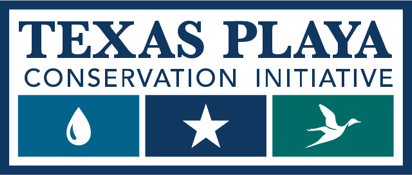
Playas, though they may go unappreciated for the life-giving role they play, are critically important recharge wetlands in the Texas High Plains. In the midst of a landscape filled with towns, industries and agricultural activities that mine multiple feet from the aquifer annually, playas give water back to the Ogallala aquifer. Despite their priceless capacity to give back in support of water for the region, playas are losing their function and fading away at an alarming rate.
Those messages were pressed home by Don Kahl, Region 1 Migratory Gamebird Specialist with the Texas Parks and Wildlife Department, who is working diligently with the Texas Playa Conservation Initiative (TxPCI) to restore altered playas to fulfilling their role in the water cycle, and Dr. Chris Grotegut, an area farmer who includes playas in his “live within your means” irrigation management. Kahl and Dr. Grotegut made comments and conducted a field trip at a recent playa landowner field day that included a classroom session at the Hereford Community Center and a visit to a local playa near Dawn.
Some 23,000 of roughly 80,000 playas in the Great Plains states are located in the Southern High Plains of Texas, primarily in the Panhandle and South Plains. Within the Panhandle region, these ephemeral basins could appropriately be called recharge wetlands as they are strongly tied to the Ogallala aquifer.
“We’re trying to get away from calling playas ‘lakes’ as functioning playas have both dry and wet periods. Playas help recharge the Ogallala aquifer and their dry periods are important to recharge due to the large cracks that form in their clay floors when they dry out. The initial rush of recharge is through these cracks when rainwater flows in during thunderstorms, and as the clay swells and seals the recharge occurs on the perimeter of the playa where the hydric soil meets the upland soil in the annular ring of the playa,” says Kahl, who is based in Lubbock.
“Healthy playas ensure recharge of clean water into the Ogallala aquifer. The recharge rate through playas is 10 to 100 times greater than elsewhere. Water that is filtered through playas most benefits wells pumping from the Ogallala aquifer. Three inches of recharge through a four acre playa produces 326,000 gallons of returned water. That’s enough to support two years of residential use for a family of four,” emphasized Kahl.
“Water recharged through playas stays localized where the playa lies. Recharge can range from an inch or less up to 20 inches. The average playa is 17 acres, so that’s considerable water recharged from an average-sized playa—far more if the recharge rate is on the high end of up to 20 inches,” Kahl projected.
The health of the Ogallala is a major concern on the Texas High Plains, where massive historic declines in the freshwater aquifer have occurred due to heavy irrigation and residential use. Land use patterns in agriculture and urban sprawl have both had substantial impact on the function of playas.
Kahl says Texas has a total of 23,037 playas. Of that number, 4,080 are currently categorized as pristine—functional thanks to a good grass buffer around them, no trenching, and no accumulated silt in the basin. Another 5,631 are currently listed as functional but at risk, and a troubling tally of 13,326 playas are categorized as not functional.
Kahl is working with the Texas Playa Conservation Initiative, launched in 2015, to rehabilitate playas listed as not functional. Others partnering with Texas Parks and Wildlife Department in the effort include Playa Lakes Joint Venture, Natural Resources Conservation Service, Ducks Unlimited, Texan by Nature, U.S. Fish and Wildlife Service, and Ogallala Commons.
“Our focus is on backfilling tailwater pits in grass-buffered playas. A hole in the clay pan of a playa, such as a tailwater pit, is a hole in the playa’s filter mechanism. Water gathered in a pit is not productive like rainwater spread shallowly over a whole playa basin. With pits, you lose the shallow water habitat,” Kahl told the workshop audience.
Kahl says TxPCI seeks playas it would like to restore and works with the landowner. The initiative pays 100 percent of restoration costs and hires and directly pays contractors involved in pushing berms alongside tailwater pits back into the pit.
“Playa landowners receive a one-time incentive payment of $80 per playa acre, and must enter into a ten-year agreement that precludes future pit creation in the playa. We contact landowners directly and make site visits prior to entering into contracts. TxPCI pays the landowner and the contractor. Playas that get pit backfilling are remotely monitored,” said Kahl.
The initiative has projects in Castro, Floyd, Swisher Briscoe, Hale and Armstrong counties thus far.
“We have completed 13 pit filling projects with 489 playa acres restored. Thus far, TxPCI has spent an average of $12,305 per project. That’s pretty cheap for wetland restoration,” Kahl said.
He says the initiative hopes to have 25 projects underway in the next couple of months.
Primary funding for TxPCI is via migratory gamebird funds through the Texas Parks and Wildlife Department, federal and North American Waterfowl Conservation Act grants, and regional grants from the U.S. Fish and Wildlife Service.
“We’re beginning to need more staffing now as this project builds momentum. This effort shows that water conservation goes beyond what you do in your household. It’s important to realize where your water comes from, and the important role that playas play in keeping Ogallala aquifer water available,” said Kahl.
By Jim Steiert, an award winning member of the Texas Outdoor Writers Association and a Certified Texas Master Naturalist. Photo of playa courtesy of Darryl Birkenfeld.
